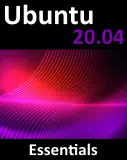Notes from the Author
| Previous | Table of Contents | Next |
| Table of Contents | About Ubuntu Linux Essentials |
My first exposure to anything that looked anything like Linux was providing technical support on a UNIX based system. This was both my first job and my first exposure to an enterprise level operating system. For the first six months I hated the cryptic nature of the UNIX command line tools and woke each weekday morning with a sinking feeling that I was going to once again spend a day battling this operating system. Gradually I began to appreciate the power, flexibility and simplicity of the various components that comprised the UNIX operating system.
In later years I moved into other areas of the IT business and used UNIX less. After relocating across country I found myself faced with setting up a network of systems for a new office and found myself immersed once again in the world of networks and operating systems. I very quickly standardized on Linux as the operating system of choice and equally quickly found myself re-using many of the skills I'd learned from my UNIX days, together with much that is new in Linux.
In order to further broaden my Linux knowledge I decided to attend the monthly local Linux User Group meetings. At these meetings I was humbled by the depth of Linux knowledge of the other attendees and learned more about Linux from these experts than I ever could have hoped for (given that the meetings are held at Red Hat's headquarters this is hardly surprising). One month, a member of the user group committee announced that a representative for Ubuntu would be speaking at the next meeting, at which a loud and sustained cheer rose up from the audience. At this point I had never heard of Ubuntu and had no idea what it was that these experts were so enthusiastic about. All I knew was that if these people thought it was great then I had better find out what it is. I drove home, fired up a web browser and searched for Ubuntu. I quickly found out it was a Linux distribution. How can these people be so excited about "just another Linux distribution"? I had to find out. I slid the Ubuntu Linux Live CD I'd picked up at the meeting into my CDROM tray and booted from it. Several hours later I had my answer. Ubuntu Linux was a nice, easy to use and easy to maintain Linux system. Clearly, a lot of work had gone into making Ubuntu easy to try, install and use, and yet I could still drop down to the low level to perform the more advanced tasks I was used to performing when I needed to.
A few months later I decided it was time to write about Ubuntu and try to give others the chance to find out why Ubuntu Linux is such a popular Linux distribution. The first edition of Ubuntu Linux Essentials is now complete, but will continue to evolve as Ubuntu gains new features and I learn more about it. I hope you find this book useful.



